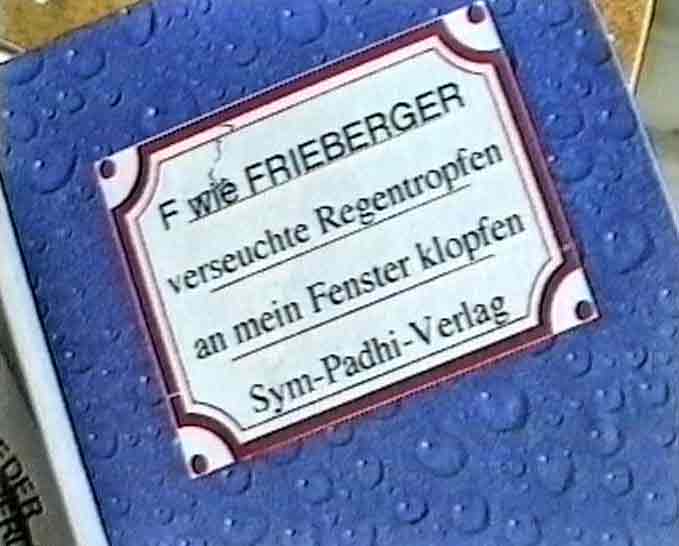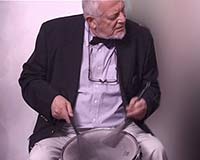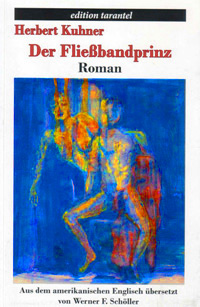Too Much Cotton
Orson Welles reaped great praise for Touch of Evil, a sloppy job compared with Kane, but nevertheless with moments of greatness like all post-Kane films.
A corpulent Welles plays a dishevelled cop, but he felt needed a bit of padding for the jowls, so cotton was the answer. The padding is too much of a bad thing. Guess the Kane make-up man was not available. Ditto for Brando’s elderly Mafioso in Godfather! His comeback got him an Oscar but you know that the cotton is there,
and knowing it as well as having it, makes chills run up and down your spine. It must have affected the acting in one way or another. Guess the Oscar jury ignored it. Master-actor Larry Olivier would have said: “Why don’t you try acting, dear boy?!” And he might have added: “Fire the makeup man!”

Touch-of-Evil-Menzies-Quinlan
Orson
I started at the top and worked my way down.
– Orson Welles
Orson Welles often pulled the chestnuts out of the fire,
but he threw them in just as often.
I saw Citizen Kane in 1955 at the 55th St Playhouse, which is off Seventh Ave. At the time it was still an “art house.” Years later it was transformed into a porn theater, like so many art houses. Perhaps there is a connection, since the old art houses showed European films in which there was sometimes a glimpse of nudity, the only glimpses in those puritanical days. Now those venues show the blow-by-blow blow-ups of the real McCoy.

No doubt about it, Orson was a bit of a mountebank and a conjurer, not to say impostor. In young years, he learned the tricks of a magician. That’s how he won Rita Hayworth. He put on a magic show and she was the decoration. Orson sawed her in half, and when he put her together again, she was so dazzled that she married him. A Hollywood star married a Hollywood man. He may have been a maverick, but he started out as a Broadway maverick and became a Hollywood maverick. Yes, you can’t imagine Welles without Hollywood, nor can you imagine Hollywood without Welles.
Orson was a wheeler-dealer who could talk people into doing things for him. He sold Harry Cohn of Columbia the idea of buying a book that he had spotted in a pocket book rack in a drugstore while on the phone. Harry bought the book and forked over forty grand to Orson, which was a lot of dough in the Forties. When read, the unread Lady turned out to be so lousy that Orson had to write the script form scratch. The only part of the book that survived in the film was the title.
Welles had put Harry Cohn on, and Harry would get even with him. The question is: Did Orson Welles the magician, at times, put the public on?
Orson, prior to Citizen Kane, was the greatest juggler of the performing arts that the world had ever seen, but after Kane he dropped balls all over the place. Before the age twenty-five, you may be able to bat around from radio shows to the theater and to the film studio, but after that, juggling becomes more difficult, and you have to hang around to complete a job until it’s finished to your satisfaction. But juggling well or badly wasn’t the whole story. Lady Luck had been Orson’s constant companion up to Kane, but afterwards she abandoned him and the magic went with her.
Biting off more than you can chew invariably means ending up with a stomach ache.
In Kane, Welles went about “inventing” cinema. Here’s what Gregg Toland, the great cameraman, had to say: “I want to work with someone who’s never made a movie. That’s the only way to learn anything – from someone who doesn’t know anything.” In other words, being new at the game, Welles was bound to do things that you shouldn’t do.
What Welles didn’t know, he learned. And he learned it like no one before or after him.
Here’s an example of direction by Orson: “Gregg, I want to see that light before the sun comes up. Toland replies “Well, we never have that in movies.” “We should,” says Orson. And Gregg went about doing what Orson had suggested. The result can be viewed in the all-night newspaper scene in Kane.
Welles hadn’t seen many films before directing Kane, and he didn’t see many after Kane.

His motivation: “Innocence is quite a serious concern. The better another man’s film may be, the more I stand to lose by seeing it. When I look through the camera, I need to look with my own innocent eye – to stand alone with every new scene, not in the company of other directors, however august.”
His aspiration: “I want to use he motion picture camera as an instrument of poetry.”
And his definition: “A film is a dream, but a dream is never an illusion.”
Kane was Joseph Cotten’s first film. He made his debut playing an aged Jedediah Leland in the famous hospital scene. “Orson, you promised to break me in gently. I’ll probably go on playing old men’s parts until I’m fifty, then people will say: “My, doesn’t Cotten preserve himself remarkably well. He hasn’t changed a bit in twenty years.”
The Goliath that David chose to strike down in Kane was William Randolph Hearst, the tabloid magnate, and probably the most powerful and influential man in America. By making Kane, David had struck Goliath and everything Goliath stood for, right smack on the temple with a celluloid stone. Goliath, the purveyor of reactionary mediocrity, got up swinging, and used his yellowsheet power to bring David down as a filmmaker.
A wounded Welles, got up to direct and act in other films, but the damage Hearst rendered was permanent.
Welles could never get it together again after Kane, or if he did get it together, others took apart.
There would be flashes of brilliance – but only flashes.
No doubt about it, Hearst was Kane’s model, but the film was more than a film à clef, and it transcended the biographical aspects. And it is much more than a statement about power and wealth.
In my opinion, as well as the opinion of many others, Kane was and is the greatest American film ever made, if not the greatest film of all time. The more it ages, he fresher it becomes. In these days of color, it makes the best case for the merits for the black and white film. And in these days of location scenes, it makes the best case for studio shots.
Sam Goldwyn of the Metro duo loved Kane, but Louis B. Mayer, the other half, at Hearst’s behest, tried to buy up all the copies to destroy them. Louis assayed the destruction of Kane after the Third Reich book bonfires in Berlin. The MGM mogul needs a good sophist in his corner to justify his American attempt.

Sam Goldwyn
Kane was not Gone with the Wind, which is nothing to be ashamed of. At the time it was a financial flop, with a little help from Hearst and his minions, but it would prove to be a major grosser in the long run. It may not be the greatest grosser of all time, but if you want to judge the quality of films – or books – by the amount of money they make, judging merit would be a very simple matter.
Welles had a terrific supporter in George Schafer, RKO studio head, but Kane would also bring about his downfall. You can compare Schafer to Maxwell Perkins, the great Scribners’ editor of Fitzgerald, Hemingway and Thomas Wolf, in the field of literature. And you can compare him to Paul Whiteman, the foremost promoter of jazz, as well as of composers like Gershwin and Grofé, in the field of music
Welles chose a Booth Tarkington novel as his second film subject. He continued his juggling act and his peripatetic habits, but managed to complete The Magnificent Ambersons to his satisfaction. Catastrophic comments by a teenage audience at a sneak preview put RKO in a dither, and the moguls got panicky. Welles the juggler was off in Brazil working on his documentary, It’s All True, which would never reach completion. Years later it would turn up as a fragment. In his absence Schafer was fired and replaced by Charles Koerner, who was the antithesis of Schafer. Koerner asked William Wyler to doctor up Ambersons, but Wyler, a man of integrity, refused out of respect for Welles. Jack Moss, Welles’ business manager and a true Judas, was the first to use the shears. Director Robert Wise also tampered with the film by cutting it and shooting new scenes. Robert Wise was Robert Dumb for consenting to bowdlerize a great director’s film. But bowdlerizing wasn’t enough for Koerner, who ordered the cut footage destroyed. Thus Koerner and Louis Mayer take the cake as the arch villains of the film industry. Instead of concentrating on the Ambersons situation, Welles was off fiddling with Journey into Fear, which he co-directed with Norman Foster. Foster needed Welles help since he couldn’t make heads or tails out of the slapdash script. Welles mourned that Journey had been “run through a broken lawnmower.” (That very same lawnmower was oft used on his films, and damn it, he failed to salvage the pre-lawnmowered versions.) Journey, ended up as a badly-cut pot boiler with a corpse turning up alive after it had been killed. Working slapdash and piecemeal can only lead to catastrophe, and it did for Welles.
Welles claimed that Ambersons, in its original form, was a better film than Kane. And I may be a smart aleck for saying this, but Welles should have been present to take care of his film, instead of being elsewhere. He couldn’t have stopped the mutilation of the film, but he could have saved the cut footage, at gunpoint if need be. An artist’s work is his spiritual property, and no one has the right to destroy it. But you can’t take care of your property if you’re not at the scene of the crime.
(Now, belatedly, the complete Magnificent Ambersons can be viewed – not the Welles film, however. A TV-film, based on the original screenplay, was shown in 2002, with a new director and cast.)

Orson-Welles
Welles was not the only one to fail to prevent cut film material from being discarded. John Huston’s Red Badge of Courage suffered the same fate as Ambersons. It was pared down to 68 minutes by MGM (Louis B. Mayer again) and ended up as the second half of a double-feature bill. Huston, who had directed commercially successful films, apparently couldn’t prevent the studio bosses from slicing away, and he too did not preserve the discarded material.
After a career of masterpieces like The Maltese Falcon, Fat City and Wise Blood, as well as mediocre commissions like “The Bible,”Huston ended his life by setting an example for all artists. As a dying man in a wheelchair, with an oxygen mask within reach, Huston tackled James Joyce’s unfilmable, The Dead. In the manner of great artists, he defied Death, but Death, always intent on being the Master, took him before he could complete it. His son Danny had to add the finishing touches. The result is an immortal film of an immortal story.
Erich von Stroheim, who expressed admiration for Kane after its premiere, was the precursor of Welles as a man of self-indulgence. He invariably overextended his shooting schedule and delivered films that went far beyond feature length. His films were paired down and, you guessed it, the cut material was not preserved. Thus Stroheim can only be judged by the fragmentary works that are left.
The question is: were these men more sinned against than sinning?
As an artist, I am on the side of the artist, but if an artist does not deliver work called for in his contract, he must share the blame for the consequences. The fates of Stroheim and Welles invite comparison. They were both directors who aided their adversaries in ruining their chances. Self-indulgence is the trait most helpful in achieving an artist’s downfall.
After Ambersons, Welles would make films with moments of brilliance, but he would never carry through as he did on Citizen Kane. And, like Stroheim, he lend himself to a lot of lulus.
There were many films that he couldn’t live down. Here’s Bosley Crowther in The New York Times describing Tomorrow Is Forever, a tearjerker starring Claudette Colbert and directed by Irving Pichel: “…a straight piece of Hollywood taffy, slightly saline and gooey clear through.” Orson’s comment: “I was deeply ashamed,”
After he left the United States, he also abandoned American themes, with the exception of Touch of Evil, something I regret, since he had handled them so well.
Macbeth was a quickie in the Scottish burr. The witches take an effigy of Welles out of their witches brew, and when Macduff deals the death blow to Macbeth, the effigy is beheaded by the witches in an insert. A brilliant slice of Welles.
Othello was made piecemeal with actors in the cast who could not speak English. As a remedy, Welles dubbed the voices of several characters with his inimitable organ. (Ditto for the dubbing of The Trial.) Compared to the brilliantly fluctuating soundtrack of Kane, these fall shorter than short. But there I go: comparing these shoestring efforts to the first technically-polished and properly-financed effort that has been deservedly called a masterpiece.
Welles had been born to play Iago. He had assayed the role previously, alias Harry Lime, opposite Joseph Cotten in The Third Man and, alias Caesare Borgia, opposite Tyrone Power in the Prince of Foxes. In Othello, he chose to play the Moor. It could very well be that he had become too bulky to play the slinky villain.
In Chimes at Midnight, Welles had accumulated the girth necessary for Falstaff, but in my view he took himself too seriously to be able to play a comic role.
In Touch of Evil, Welles owed his directing credit to Charlton Heston. He was hired to act in it, and when the studio approached Heston, he said: “Any picture that Orson Welles is directing, I‘ll be glad to be in.” So the studio promoted Welles in order to get Heston.
Touch was Heston’s only film that had a B-film budget – and unfortunately it was treated accordingly. The studio bosses weren’t very sanguine about the chances of the dark, seamy film that Welles had delivered.
Welles’ makeup added to the overall impression. He was hopelessly overweight, but that did not suffice. He padded his body and the cheeks of his stubbled face.
But no matter how thick the makeup, he could never disguise himself. Welles always seemed to be Welles, alias Kane and alias Harry Lime.
Here’s an incident related in Peter Bogdanovich’s This is Orson Welles.
Orson: “We had seven weeks of overnight shooting – beginning at night and ending at dawn – And I’ll never forget Chuck Heston one night, at the end of those of those seven weeks seven weeks. He was on the far side of the bridge, and I told him to quickly cross over in a shot. Dawn was about to rise and he said, without irony or anger, very sweetly “Do you mind telling me why I’m crossing the bridge?” And I said, “No. just cross the bridge, and when you get here I’ll tell you.”
Peter: “You were losing light –“
Orson: “Yes – that’s why he was crossing the bridge, as I later explained to him.”
In Touch Marlene Dietrich tells Orson’s corrupt cop, “You’re a mess, baby.” That comment became a famous quote and dogged Orson for the rest of his life.
In Mr. Arkadin Welles made a mess. He assessed the film as “a flawed masterpiece…a disaster,” actually a contradiction in terms. Mercury-Player Joseph Cotten, installed his wife Patricia Medina in Arkadin. Mrs. Cotten was a B-film actress who bestowed a B-film aura to any film she appeared in.
(Charles Bronson carried on the tradition by stipulating that Jill Ireland’s name be inserted in every film contract. Mrs. Bronson was a desirable, sloe-eyed beauty, but her acting left a lot to be desired. Cotten and Bronson may have been ideal husbands, but they were guilty of film nepotism in the first degree.)
And again the old lawnmower had been brought into play.
Welles opens The Trial by reading The Doorkeeper off screen to abstract shades of black and white, a masterful rendition of the Kafka story. After the magnificent prologue, Tony Perkins looks out of place scurrying through European rubble and ruins in a Madison Avenue suit.
And so on.
In order to finance these efforts, there were many small parts in incidental films. Welles, the elder actor, said of himself: “They hire me when they have a bad film and they want a little class. I chip away a little of myself each time.”
However, Welles turned down a million dollars for a starring role in Caligula in 1980. The producer was Playboy Enterprises directed by Tinto Brass. After Welles read the Gore Vidal script, he had a premonition of the violent stinkbomb that would emerge and said “No.” Since this major venture, Brass has gone back to making spaghetti porn, with the emphasis on the physical attribute that rhymes with his last name.
Welles said that he’d rather be behind the camera than in front of it. Indeed he was not what you would call a versatile actor and was often accused of overacting. But whether good or bad, he was always interesting to watch, and the mellifluous voice was always worth listening to.
And no matter what film he was in, film, he did “add a bit of class.”
Here’s Welles’ theory on screen presence as expressed by Akim Tamiroff: “De box looks at vun fellow, and de box says ‘Yes, dot vun is for me!’ It looks at annoder, and it says, ‘Nawww!’”
He mentions Gary Cooper as actor who could do no wrong in any film. And come to think of it, he was right. The camera loved Gary.
I always enjoyed reading Pauline Kael, who left us at the ripe old age of 82. Her tastes weren’t my tastes, and she was never in my good books, but her descriptions of actors and scenes in films were brilliant. I’ve often wondered why critics who write so well don’t write fiction. But when she bashed Welles as director of Citizen Kane, she took a place in my bad books, right next to arch-villains Louis B. Mayer and Charles Koerner.
Imagine, trying to rob Welles of his one masterpiece! In Raising Kane, she claimed that Welles lifted the script from co-scriptwriter Herman Mankiewicz and took credit for the contributions of other members of his staff.
Let me interject that his older contemporaries barred young Picasso from their studios. They were afraid that he’d steal their ideas. He may have indeed have taken from others, but there is no doubt that Picasso was Picasso. And here’s Picasso on stealing: “It’s a poor artist who borrows – a good artist steals.”
It is true that Manky knew intimate Hearst details, which he passed on to Welles. The “Rosebud” emblazoned on young Foster’s sled is alleged to be the pet name Hearst used for Marion Davies’ Holy of Holies.
I wasn’t there to witness the situation, but I know that whatever Welles took from others, only he, Orson Welles, and no one else, could have put Kane together. The making of a film is and isn’t an individual business. It entails teamwork.
The film bears the mark of Orson Welles, who captained the finest team that anyone could put together.
When weighing the work of Welles, the Mercury and other theater productions should be placed on the scales. But unfortunately, in contrast to film, this ephemeral medium is only retained in photos, reviews and memory.
Welles keeps turning up in my writing and in my thoughts. I may have brought some negative aspects into this sketch, but they could never unfocus my admiration for a singularly great director and personality.
Quotes and information from Orson Welles and Peter Bogdanovich: This is Orson Welles, HarperCollins, 1993.

The Son of Kane
You couldn’t film a prequel to Citizen Kane because the film begins with Kane’s childhood, and you can‘t film a sequel since the film ends with his death. So The Return of Kane is out. The only other possibilities are The Son of Kane or Kane’s daughter.
“What’s that? Kane died childless?
“Don’t be ridiculous! A son or daughter could very well show up. It wouldn’t be the first time progeny came out of the blue. The mother has to know – but not necessarily the father!
There was The Son of Monte Cristo, The Son of Robin Hood. The Son of Ali Baba and The Son of Frankenstein. There were sons galore, including the Sons of King Kong and Godzilla. Ditto for daughters. There was The Daughter of Rosie O’Grady and The Daughter of Dr. Jekyll, So why shouldn’t there be The Son of Kane – and maybe a daughter-sequel to that.
The intellectual crowd is a cinch, since they’ll want to see how the Kane story develops. They’re not to be scoffed at. After all they keep Woody Allen afloat, don’t they? And we’ll make the film appealing to the average moviegoer. He wants to see a classy film, now and then, just to prove that he’s not lowbrow.
“Now Listen! Kane was shot in black and white, and there was no nudity in those days. We’ll shoot the Son-film in color and spice it up with some nude scenes. We’ll see to it that the sequel is even better than the original.
Junior will be modeled on Murdoch, but we’ll be sure to show his good side. That way, we’ll avoid the kind of trouble that Hearst caused for the Welles Film.
How can we miss? This one will be in the bag. And then we’ll see what we can do with the daughter?
-Herbert Kuhner










 Users Today : 25
Users Today : 25 Users Yesterday : 144
Users Yesterday : 144 This Month : 2422
This Month : 2422 This Year : 22706
This Year : 22706 Total Users : 180801
Total Users : 180801 Views Today : 29
Views Today : 29 Total views : 1874917
Total views : 1874917 Who's Online : 1
Who's Online : 1

















